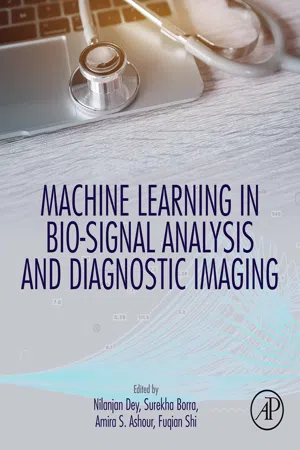
Machine Learning in Bio-Signal Analysis and Diagnostic Imaging
Nilanjan Dey,Surekha Borra,Amira S. Ashour,Fuqian Shi
- 345 pagine
- English
- ePUB (disponibile sull'app)
- Disponibile su iOS e Android
Machine Learning in Bio-Signal Analysis and Diagnostic Imaging
Nilanjan Dey,Surekha Borra,Amira S. Ashour,Fuqian Shi
Informazioni sul libro
Machine Learning in Bio-Signal Analysis and Diagnostic Imaging presents original research on the advanced analysis and classification techniques of biomedical signals and images that cover both supervised and unsupervised machine learning models, standards, algorithms, and their applications, along with the difficulties and challenges faced by healthcare professionals in analyzing biomedical signals and diagnostic images. These intelligent recommender systems are designed based on machine learning, soft computing, computer vision, artificial intelligence and data mining techniques. Classification and clustering techniques, such as PCA, SVM, techniques, Naive Bayes, Neural Network, Decision trees, and Association Rule Mining are among the approaches presented.
The design of high accuracy decision support systems assists and eases the job of healthcare practitioners and suits a variety of applications. Integrating Machine Learning (ML) technology with human visual psychometrics helps to meet the demands of radiologists in improving the efficiency and quality of diagnosis in dealing with unique and complex diseases in real time by reducing human errors and allowing fast and rigorous analysis. The book's target audience includes professors and students in biomedical engineering and medical schools, researchers and engineers.
- Examines a variety of machine learning techniques applied to bio-signal analysis and diagnostic imaging
- Discusses various methods of using intelligent systems based on machine learning, soft computing, computer vision, artificial intelligence and data mining
- Covers the most recent research on machine learning in imaging analysis and includes applications to a number of domains
Domande frequenti
Informazioni
Ontology-Based Process for Unstructured Medical Report Mapping
† Laboratory of Bioinformatics, Graduate Program in Electrical Engineering and Computer Science, Western Paraná State University, Foz do Iguaçu, Brazil
‡ Service of Coloproctology, Graduate Program in Medical Sciences, University of Campinas, Campinas, Brazil
Abstract
Keywords
1 Introduction
2 Related Work
Indice dei contenuti
- Cover image
- Title page
- Table of Contents
- Copyright
- Contributors
- Preface
- Chapter 1: Ontology-Based Process for Unstructured Medical Report Mapping
- Chapter 2: A Computer-Aided Diagnoses System for Detecting Multiple Ocular Diseases Using Color Retinal Fundus Images
- Chapter 3: A DEFS Based System for Differential Diagnosis Between Severe Fatty Liver and Cirrhotic Liver Using Ultrasound Images
- Chapter 4: Infrared Thermography and Soft Computing for Diabetic Foot Assessment
- Chapter 5: Automated Classification of Hypertension and Coronary Artery Disease Patients by PNN, KNN, and SVM Classifiers Using HRV Analysis
- Chapter 6: Optimization of ROI Size for Development of Computer Assisted Framework for Breast Tissue Pattern Characterization Using Digitized Screen Film Mammograms
- Chapter 7: Optimization of ANN Architecture: A Review on Nature-Inspired Techniques
- Chapter 8: Ensemble Learning Approach to Motor Imagery EEG Signal Classification
- Chapter 9: Medical Images Analysis Based on Multilabel Classification
- Chapter 10: Figure Retrieval From Biomedical Literature: An Overview of Techniques, Tools, and Challenges
- Chapter 11: Application of Machine Learning Algorithms for Classification and Security of Diagnostic Images
- Chapter 12: Robotics in Healthcare: An Internet of Medical Robotic Things (IoMRT) Perspective
- Index